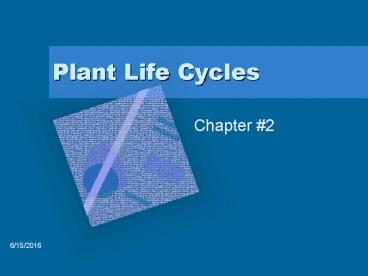Plant Life Cycles - PowerPoint PPT Presentation
1 / 29
Title:
Plant Life Cycles
Description:
Plant Life Cycles Chapter #2 What is a Life Cycle? from the time a seed is planted until a seed is produced What are the Life Cycles? Annuals, Biennials, & Perennials ... – PowerPoint PPT presentation
Number of Views:170
Avg rating:3.0/5.0
Title: Plant Life Cycles
1
Plant Life Cycles
- Chapter 2
2
What is a Life Cycle?
- from the time a seed is planted until a seed is
produced
3
What are the Life Cycles?
- Annuals, Biennials, Perennials
4
Annual
- complete life cycle in one growing season
- can be summer annuals (spring wheat, barley) or
winter annuals (winter wheat)
5
Biennials
- require two growing seasons to produce seed
- first season plant produces vegetation, second
season seed (sugar beet, carrot)
6
Perennials
- indefinite growth, can produce seed annually
(grasses, trees, shrubs, onion)
7
What is a Seed?
- package containing an embryo (miniature plant)
and food - seeds are alive, need air
8
What is Germination?
- process where embryo changes to seedling (growing
plant)
9
What conditions are necessary for germination?
- 1) moisture
- 2) correct temperature
- 3) air
- 4) some seeds need light
- 5) some seeds need help (break seed coat
sunflower, remove a chemical from seed, heat,
chill winter wheat)
10
What are Warm Season Crops?
- soil temperature must be 70 degrees F or more for
germination (corn, rice, cotton, melons)
11
What are Cool Season Crops?
- soil temp below 70 degrees F (wheat, barley,
beets)
12
How deep do seeds need to be planted?
- the size of the seed determines
- larger seed deeper
- corn 4"
- bluegrass 1/4"
13
Germination Process
- 1) seed absorbs water, swells
- 2) water activates enzymes which help digest
stored food - 3) root grows
- 4) shoot emerges (is now a seedling)
14
What is vegetative growth?
- plant produces food for itself
- extra food is stored in roots, stems, etc.
15
What is Tillering (Stooling)?
- when new stems are formed in grass plants
16
What is Jointing?
- stems of grass plants elongate rapidly
17
What is Respiration?
- process how plants get energy from its stored food
18
How is food stored in plants?
- form of carbohydrates (sugars)
19
How does respiration work?
- Food Oxygen --gt Carbon Dioxide Water Energy
20
What factors can influence the rate of
respiration?
- 1) high temps high rate of respiration
- 2) high amounts of light high rate
- 3) high amounts of water high rate
21
What is Photosynthesis?
- process of converting water and carbon dioxide
into food (sugar) and oxygen in the presence of
chlorophyll and light - photosynthesis and respiration are opposite cycles
22
What is Transpiration?
- process of returning water to the air (in the
form of gas) - 99 of water taken in by roots is transpired
- Wilt plant transpires more than it takes in
23
What are Nutrients?
- elements needed by plants to grow
24
What are Macronutrients?
- needed in large amounts
- C, H, O, N, P, K, Ca, Mg, S)
- plants get C, H, O from air and water
25
What are Primary Nutrients?
- N, P, K
26
What are Secondary Nutrients?
- Ca, Mg, S
- needed less
27
What are Micronutrients?
- needed in small amounts, but essential
- excess amounts are toxic
- Fe, Bo, Mn, Zn, Mo, Cu, Cl
28
16 Essential Nutrients
- C HOPKNS CaFe Mg B Mn CuZn ClMo
- C Hopkins Café Managed By Mine Cousin Clomo
29
(No Transcript)































